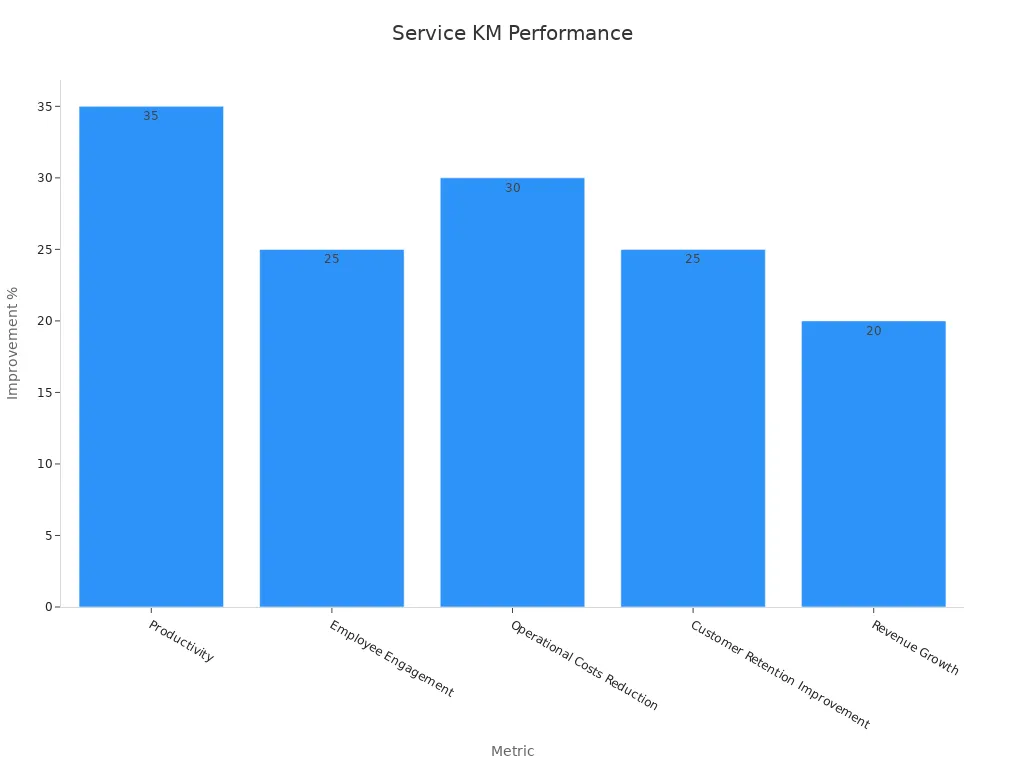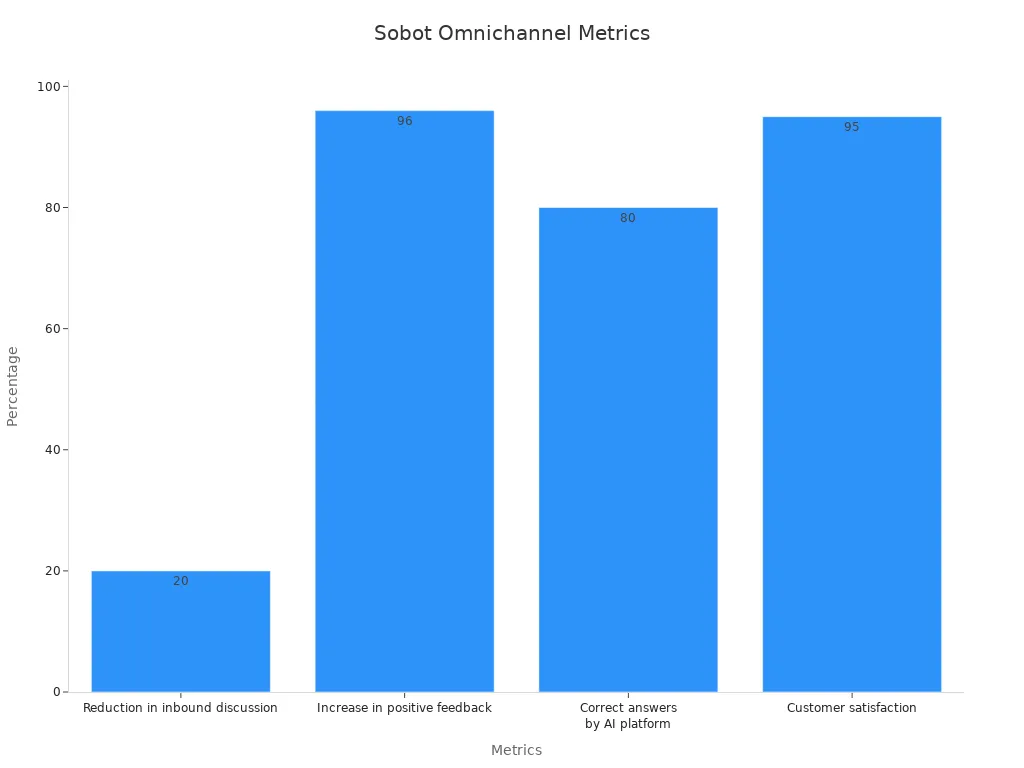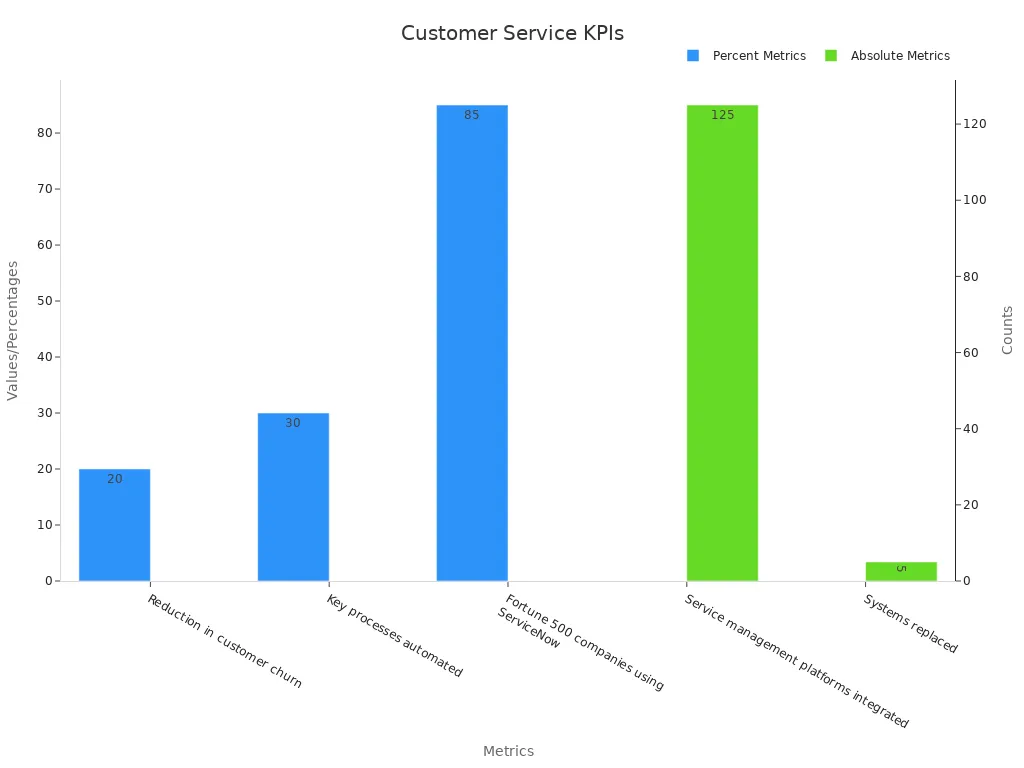Customer Service Knowledge Management Systems and Their Benefits

Customer service knowledge management systems play a crucial role in organizing and delivering information to support teams and customers. These systems ensure that agents can access accurate and up-to-date resources quickly. Studies show that 47% of employees spend hours daily searching for information, causing inefficiencies. By streamlining access, these systems enhance productivity and enable faster responses. Customers also benefit, as 78% prefer solving issues independently when provided with the right tools. This leads to improved customer satisfaction and loyalty. Sobot’s innovative solutions empower businesses to deliver effective customer service, fostering lasting relationships.
What Are Customer Service Knowledge Management Systems?
Definition and Purpose
Customer service knowledge management systems are tools designed to collect, organize, and distribute information to support teams and customers. These systems ensure that your team has quick access to accurate and up-to-date resources, enabling them to provide efficient and consistent service. For customers, these systems offer self-service options, such as FAQs and knowledge bases, allowing them to resolve issues independently.
The purpose of a knowledge management system is to streamline information sharing. It helps reduce the time spent searching for answers, improves the quality of customer interactions, and ensures that valuable knowledge is retained within your organization. Studies show that 80% of users save at least 1-2 hours weekly by using these systems, while 90% report feeling less frustrated at work. This highlights how these systems enhance both efficiency and employee satisfaction.
Key Features of Knowledge Management Systems
A robust knowledge management system includes several essential features that make it effective for customer service:
- Centralized Knowledge Base: A single repository where all information, such as product details, troubleshooting guides, and policies, is stored. This ensures that your team and customers can access consistent and accurate information.
- Search and Retrieval Tools: Advanced search capabilities allow users to find relevant information quickly. Metrics like bounce rates and time on page help assess the effectiveness of these tools.
- Integration Capabilities: Seamless integration with customer support platforms, such as CRM systems, ensures that your team can access knowledge directly within their workflow.
- Analytics and Feedback Mechanisms: Tools to track user satisfaction and identify areas for improvement. For example, binary feedback forms at the end of articles can help you understand which resources are most helpful.
- Self-Service Portals: These portals empower customers to find answers independently, reducing the need for direct interaction with support agents.
Quantitative analyses reveal that these features significantly improve service quality. For instance, businesses using knowledge management systems report a 40% decrease in average response time and a 25% increase in productivity.
Examples of Knowledge Management in Customer Service
Knowledge management systems play a vital role in various customer service scenarios. Here are some examples:
- Empowering Service Representatives: Agents can resolve queries independently by accessing a centralized knowledge base. This reduces customer wait times and enhances satisfaction.
- Improving Self-Service Options: Studies show that 61% of customers prefer self-service options, and 65% have used knowledge bases. These tools provide 24/7 support, making them both cost-effective and efficient.
- Simplifying Employee Training: Centralized access to training materials reduces the need for repetitive training sessions. This ensures that new employees can onboard quickly and effectively.
- Enhancing Customer Experiences: A well-maintained knowledge base offers customers quick answers, improving their overall experience. For example, businesses with excellent service see 93% of customers likely to make repeat purchases.
These examples demonstrate how knowledge management systems can transform your customer service operations. By implementing these systems, you can achieve faster resolution times, better customer experiences, and improved operational efficiency.
How Do Customer Service Knowledge Management Systems Work?
Capturing and Organizing Knowledge
Customer service knowledge management begins with capturing and organizing information effectively. This process ensures that your team has access to accurate and relevant resources when they need them. A knowledge management system collects data from various sources, such as customer interactions, product manuals, and internal documents. By centralizing this information, you can eliminate silos and create a unified flow of knowledge.
To capture knowledge efficiently, you should focus on three key areas:
- People: Encourage employees to share their expertise and insights. This fosters a culture of collaboration and ensures that valuable knowledge is not lost.
- Processes: Implement best practices for gathering, storing, and reusing information. For example, using templates for FAQs or troubleshooting guides can standardize the process.
- Analytics: Use data-driven insights to measure the success of your knowledge management efforts. Analytics can help you identify gaps in your knowledge base and improve its effectiveness.
Organizing knowledge is equally important. Proactively managing content ensures that it remains relevant and easy to find. Techniques like tagging, categorization, and regular updates can help you adapt to changing customer needs. Knowledge-centered services (KCS) also play a vital role by integrating knowledge creation into every customer interaction.
Storing and Accessing Information
Once you capture and organize knowledge, the next step is to store it securely and make it easily accessible. A robust knowledge management system provides a centralized repository where all information is stored. This ensures that your team and customers can access consistent and accurate data.
Advanced search tools are essential for quick retrieval. These tools allow users to find relevant information using keywords, filters, or natural language queries. For example, a customer searching for "how to reset my device" should be able to locate the exact guide within seconds. Metrics like bounce rates and time spent on pages can help you evaluate the effectiveness of your search tools.
The benefits of efficient storage and access are significant. According to industry data:
- Companies with effective knowledge management can improve productivity by up to 35%.
- Organizations that prioritize knowledge sharing achieve a 30% reduction in operational costs.
- Firms with well-organized knowledge bases report a 25% improvement in customer retention rates.

These improvements highlight the importance of investing in a reliable knowledge management system.
Delivering Knowledge to Support Teams and Customers
Delivering knowledge effectively is the final step in the process. A knowledge management system should provide the right information to the right people at the right time. For support teams, this means having access to a unified workspace where they can view customer data, past interactions, and relevant resources. This enables them to resolve issues quickly and accurately.
For customers, self-service options like FAQs, chatbots, and knowledge bases are invaluable. These tools empower customers to find answers independently, reducing the need for direct interaction with support agents. Studies show that 61% of customers prefer self-service options, and businesses that offer them see higher satisfaction rates.
Performance metrics reveal the effectiveness of delivering knowledge:
| Performance Metric | Description |
|---|---|
| First-contact resolution rates | Indicates the ability to resolve customer inquiries on the first attempt, enhancing efficiency and satisfaction. |
| Customer satisfaction scores (CSAT) | Reflects how well agents can provide fast, accurate, and personalized service, leading to higher customer loyalty. |
| Consistent customer experiences | Ensures uniformity in responses across various channels, maintaining brand standards and customer trust. |
By leveraging these systems, you can ensure that both your team and customers have access to the information they need, when they need it. This not only improves efficiency but also enhances the overall customer experience.
Role of Sobot's Voice/Call Center in Knowledge Management

Sobot's Voice/Call Center plays a pivotal role in enhancing knowledge management for customer service teams. It ensures that your agents and customers have seamless access to the right information at the right time. By integrating advanced technologies and user-friendly features, Sobot's solution transforms how businesses manage and deliver knowledge.
1. Centralized Knowledge Access for Agents
Sobot's Voice/Call Center provides a unified workspace where agents can access customer data, past interactions, and relevant knowledge resources. This centralized approach eliminates the need to switch between multiple platforms, saving time and reducing errors. For example, when a customer calls about a product issue, the agent can instantly retrieve troubleshooting guides or FAQs from the system. This ensures faster resolutions and consistent service quality.
Tip: Studies show that 89% of customers value quick responses during support calls. A centralized system like Sobot's helps you meet these expectations effortlessly.
2. Intelligent IVR for Efficient Knowledge Delivery
The Intelligent IVR (Interactive Voice Response) feature in Sobot's Voice/Call Center enhances knowledge delivery by guiding customers to the right resources. You can customize menus and greetings to direct callers to self-service options or the appropriate agent. For instance, a customer seeking billing information can navigate through the IVR to access automated answers without waiting for an agent.
This feature not only improves customer satisfaction but also reduces the workload on your support team. According to industry data, businesses using IVR systems report a 30% reduction in call handling time.
3. AI-Powered Voicebot for Real-Time Assistance
Sobot's AI-powered Voicebot takes knowledge management to the next level. It uses natural language processing to understand customer queries and provide accurate responses in real time. The Voicebot can handle repetitive questions, such as "How do I reset my password?" or "What are your business hours?" This allows your agents to focus on more complex issues.
Note: With AI-driven solutions like Sobot's Voicebot, businesses can achieve up to an 83% resolution rate for common inquiries, as demonstrated by OPPO's success story.
4. Analytics for Continuous Improvement
Sobot's Voice/Call Center includes robust monitoring and analytics tools that help you evaluate the effectiveness of your knowledge management efforts. You can track metrics like call resolution rates, customer satisfaction scores, and agent performance. These insights enable you to identify gaps in your knowledge base and make data-driven improvements.
For example, if analytics reveal that customers frequently ask about a specific product feature, you can update your knowledge base to address this need proactively. This ensures that your system evolves with customer demands.
5. Seamless Integration with Knowledge Repositories
Sobot's solution integrates effortlessly with existing knowledge repositories and CRM systems. This ensures that your agents can access all necessary information within a single platform. Whether it's product manuals, policy documents, or customer history, everything is just a click away. This seamless integration boosts efficiency and ensures consistent service delivery.
Fun Fact: Companies with integrated knowledge management systems report a 25% increase in productivity and a 40% improvement in customer retention rates.
6. Global Reach and Reliability
With a 99.99% system uptime and global network support, Sobot's Voice/Call Center ensures uninterrupted access to knowledge resources. This reliability is crucial for businesses operating across multiple time zones. For example, Sobot's time zone support feature allows your team to provide timely assistance to customers worldwide, enhancing their experience.
By leveraging Sobot's Voice/Call Center, you can optimize your knowledge management processes, improve agent productivity, and deliver exceptional customer service. To learn more about how Sobot can transform your operations, visit Sobot Voice/Call Center.
Key Components of Customer Service Knowledge Management Systems

Knowledge Base and Content Repositories
A customer-facing knowledge base serves as the backbone of any knowledge management system. It organizes and stores information, ensuring that your team and customers can access accurate and relevant data. Robust knowledge bases aggregate structured and unstructured data from various sources, such as product manuals, FAQs, and customer interactions. This improves the relevance of solutions and reduces operational costs.
AI tools enhance these repositories by analyzing performance and suggesting updates. For example, they flag outdated content, recommend new articles to fill gaps, and simplify complex information. Continuous updates ensure that your knowledge base evolves alongside customer needs. Companies like Virgin Pulse have successfully integrated AI agents with their knowledge bases, achieving faster and more efficient customer service.
| Evidence Type | Description |
|---|---|
| First Contact Resolution Rates | AI systems achieve first contact resolution rates greater than 80%, indicating high efficiency. |
| Continuous Knowledge Base Updates | Knowledge bases are continuously updated, enhancing the capabilities of virtual agents. |
| Data Aggregation | They aggregate structured and unstructured data from various sources, improving the relevance of solutions. |
| Proactive System Improvements | Machine learning algorithms identify trends and gaps, allowing for proactive updates and adjustments. |
| Cost Reduction | Knowledge bases reduce manual interventions, leading to lower operational costs. |
| Self-Learning Capability | The knowledge base self-learns alongside the AI system, refining performance over time. |
Search and Retrieval Tools
Search and retrieval tools are essential for accessing knowledge quickly. These tools allow you to locate relevant information using keywords, filters, or natural language queries. Advanced technologies like Retrieval-Augmented Generation (RAG) improve accuracy by integrating real-time data. For instance, Thomson Reuters used RAG to enhance customer support, achieving faster resolution times and higher service efficiency.
RAG technology transforms customer service interactions by enabling representatives to access live data. This ensures precise and contextually relevant responses. Companies like Algo Communications have demonstrated how these tools improve response speed and accuracy, leading to better customer experiences.
Integration with Customer Support Platforms
Integrating your knowledge management system with customer support platforms ensures seamless access to information. This connection allows agents to retrieve data directly within their workflow, reducing average handle time and improving first-call resolution rates. Metrics like customer satisfaction scores reflect the benefits of integration, as higher scores indicate better loyalty and retention.
Key performance metrics highlight the advantages of integration:
- First Call Resolution (FCR): Resolves inquiries in a single interaction, reducing repeat contacts.
- Average Handle Time (AHT): Tracks the total time agents spend on calls, with quicker access to knowledge improving efficiency.
- Customer Satisfaction (CSAT): Measures customer contentment, with consistent responses enhancing loyalty.
By integrating knowledge management systems with platforms like CRM, you can streamline operations and deliver consistent service across channels.
Sobot's Omnichannel Solution for Seamless Integration
Sobot's Omnichannel Solution revolutionizes how you manage customer interactions by unifying multiple communication channels into a single, seamless platform. This integration ensures that your support team can deliver consistent and personalized service, no matter where your customers reach out—be it through email, social media, live chat, or voice calls.
Key Benefits of Sobot's Omnichannel Solution
-
Unified Customer View: With Sobot, your agents can access all customer interactions and data in one place. This eliminates the need to switch between platforms, saving time and reducing errors. For example, when a customer contacts you via live chat after an email inquiry, your team can pick up the conversation without missing any details.
-
AI-Driven Efficiency: Sobot's platform leverages advanced AI to handle repetitive queries, allowing your agents to focus on complex issues. The AI achieves an impressive 80% accuracy in providing correct answers, contributing to a 95% customer satisfaction rate.
-
Improved Customer Experience: By integrating all channels, Sobot ensures that your customers receive consistent responses, regardless of how they contact you. This consistency builds trust and loyalty, especially among VIP customers, as seen with Mico App's success.
Performance Metrics of Sobot's Omnichannel Integration
The impact of Sobot's solution is evident in the numbers. Businesses using this system report significant improvements in efficiency and customer satisfaction:
| Metric | Value |
|---|---|
| Reduction in inbound discussion | 20% |
| Increase in positive feedback | 96% |
| Correct answers by AI platform | 80% |
| Customer satisfaction | 95% |

Why Choose Sobot?
Sobot's Omnichannel Solution doesn’t just integrate channels—it transforms your entire customer service knowledge management system. By consolidating data and automating workflows, it reduces agent workload and improves response times. This makes it an ideal choice for businesses aiming to enhance both operational efficiency and customer satisfaction.
Tip: Companies using Sobot's Omnichannel Solution have seen a 20% reduction in inbound discussions and a 96% increase in positive feedback. These results highlight the system's ability to streamline operations and improve customer experiences.
To explore how Sobot can elevate your customer service, visit Sobot Omnichannel Solution.
Benefits of Customer Service Knowledge Management Systems for Businesses

Improved Efficiency and Productivity
Customer service knowledge management systems significantly enhance efficiency and productivity by centralizing information and reducing time spent searching for answers. Employees often spend nearly 20% of their time looking for information. A centralized knowledge management system eliminates this inefficiency, allowing agents to focus on resolving customer issues. This streamlined access to knowledge also prevents duplication of effort, enabling your team to leverage existing solutions instead of reinventing the wheel.
| Benefit | Description |
|---|---|
| Increase employee efficiency | Employees spend nearly 20% of their time searching for information. Centralizing knowledge reduces this time significantly. |
| Improve decision-making | Access to past successes and mistakes enables informed decisions based on facts rather than assumptions. |
| Avoid reinventing the wheel | Effective knowledge management prevents duplication of effort by leveraging existing knowledge within the organization. |
These improvements translate into measurable gains. For example, 80% of users save at least one hour weekly, while 30% save up to three hours. This time can be redirected toward improving customer service and achieving business goals.
Consistent and Accurate Customer Support
A well-implemented knowledge management system ensures that your agents deliver consistent and accurate support. By centralizing information, you eliminate data silos and provide agents with immediate access to the resources they need. This uniformity in processes and decision-making leads to faster and more accurate responses, which directly enhances customer satisfaction.
- Systematic organization of information improves response times and overall customer satisfaction.
- Immediate access to organized information helps support teams resolve inquiries more efficiently.
- Centralization of information allows employees to access consistent data, facilitating uniformity in processes and decision-making.
- Codification of information ensures that support personnel have immediate access to necessary information, leading to prompt resolution of inquiries.
Tip: Consistency in customer service builds trust and loyalty. A centralized knowledge base ensures that all agents provide the same high-quality support, regardless of the channel.
Reduced Training Time for Support Teams
Customer service knowledge management systems simplify training for new agents by providing centralized access to resources. Guided workflows and online platforms allow agents to learn on the job, reducing the need for lengthy training sessions. Research shows that effective knowledge sharing during onboarding can reduce the time it takes for new employees to reach proficiency by 20%. This not only saves costs but also enables agents to contribute more quickly.
- Companies utilizing centralized knowledge bases report a decrease in average handling time due to quicker access to information.
- Guided workflows improve first call resolution, reducing the need for call transfers and holds.
- Ongoing training through online platforms keeps agents updated efficiently, minimizing the need for repetitive sessions.
By reducing training time, you can onboard new agents faster and ensure they are equipped to handle customer inquiries effectively. This approach also boosts agent confidence and productivity, leading to better overall performance.
Enhanced Insights with Sobot's Analytics Tools
Sobot's analytics tools empower you to make smarter decisions by providing actionable insights into your customer service operations. These tools help you track performance metrics, understand customer behavior, and optimize support processes. By leveraging these insights, you can improve efficiency, enhance customer satisfaction, and drive better business outcomes.
Key Features of Sobot's Analytics Tools
Sobot's analytics dashboard offers a comprehensive view of your customer interactions. It enables you to monitor key metrics and identify areas for improvement. Some of the features include:
- Detailed Interaction Reports: Analyze customer inquiries, resolution times, and satisfaction scores to pinpoint strengths and weaknesses.
- Behavioral Insights: Understand how customers interact with your support channels, helping you refine your strategies.
- Team Performance Metrics: Assess agent productivity and service quality to ensure consistent and high-quality support.
These features allow you to transform raw data into meaningful insights, making it easier to adapt your customer service knowledge management systems to evolving needs.
Benefits for Your Business
Sobot's analytics tools help you optimize your customer service strategies in several ways:
- Improved Decision-Making: Access to real-time data ensures you make informed decisions based on facts rather than assumptions.
- Enhanced Efficiency: Insights into team performance and customer behavior allow you to streamline workflows and reduce response times.
- Higher Customer Satisfaction: By identifying pain points and addressing them proactively, you can deliver a better experience for your customers.
For example, businesses using Sobot's analytics tools have reported a 25% improvement in service quality and a 30% reduction in operational costs.
Tip: Regularly reviewing analytics reports helps you stay ahead of customer expectations and maintain a competitive edge.
Why Choose Sobot?
Sobot integrates analytics seamlessly into its customer service knowledge management systems. The tools provide a unified view of data, eliminating silos and ensuring consistency across channels. Whether you're tracking customer satisfaction scores or analyzing agent performance, Sobot's analytics tools give you the insights you need to succeed.
To learn more about how Sobot can enhance your customer service operations, visit Sobot Analytics Tools.
Benefits of Customer Service Knowledge Management Systems for Customers
Faster and More Accurate Responses
A knowledge management system ensures that you receive faster and more accurate responses to your customer queries. By centralizing information, support teams can access the exact resources they need without delay. This reduces response times and improves the quality of answers. For example, when you ask about troubleshooting a product, the system enables agents to find the relevant guide immediately.
Metrics highlight the speed and accuracy improvements delivered by these systems:
| Metric | Description |
|---|---|
| First Response Time | Measures the time from a customer's inquiry to the first meaningful response from a support agent. |
| Average Response Time | Calculates the average time taken for a support team to reply to customer inquiries. |
| First-Contact Resolution Rate | Indicates the percentage of customer issues resolved on the first interaction with support. |
These metrics show how knowledge management systems enhance efficiency, ensuring your concerns are addressed promptly and accurately.
Enhanced Self-Service Options
Self-service options empower you to solve issues independently, saving time and reducing frustration. Knowledge management systems provide tools like self-serve portals and FAQs, which allow you to find answers without contacting support. These portals are especially helpful for quick solutions, such as resetting passwords or checking order statuses.
Studies reveal the effectiveness of self-service options:
- Self-service portals enhance customer satisfaction when they are user-friendly.
- Customers prefer self-service options for quick solutions, especially younger demographics.
- Knowledge bases reduce unnecessary interactions with agents, allowing them to focus on complex issues.
- Metrics like reduced call volume and increased self-service usage reflect their success.
Self-serve portals also streamline interactions, making it easier for you to access information without navigating through complex systems.
Improved Overall Customer Experience
A well-maintained knowledge management system improves your overall customer experience by providing consistent and personalized service. When you interact with support teams, they can access your history and preferences, ensuring tailored solutions. Self-service options further enhance your experience by offering 24/7 access to information.
Businesses implementing these systems report significant improvements:
- Enhanced customer satisfaction scores (CSAT) indicate better experiences.
- Higher retention rates show that customers are more likely to stay loyal.
- Increased efficiency in customer-facing operations leads to smoother interactions.
These benefits demonstrate how knowledge management systems transform your experience, making it faster, easier, and more enjoyable to resolve issues.
Case Study: How Sobot Helped OPPO Improve Customer Satisfaction
OPPO, a global leader in smart devices, faced challenges in managing high volumes of customer inquiries during peak shopping periods. These surges often led to long wait times and inconsistent service quality. To address these issues, OPPO partnered with Sobot to enhance its customer service operations and improve customer satisfaction.
Streamlining Customer Interactions with AI-Powered Tools
Sobot implemented its AI-powered chatbot and ticketing system to handle repetitive customer queries. The chatbot resolved common questions like product troubleshooting and order tracking, allowing human agents to focus on complex issues. This approach significantly reduced response times and improved the overall customer experience. For example, OPPO achieved an impressive 83% chatbot resolution rate, ensuring faster and more accurate responses for customers.
Did you know? Businesses using AI-driven chatbots report up to a 30% reduction in operational costs while improving service efficiency.
Optimizing Knowledge Management for Better Service
Sobot also helped OPPO optimize its knowledge base. By automating the input of Q&A pairs, Sobot reduced maintenance efforts by 90%. This streamlined access to accurate information empowered agents to provide consistent and reliable support. Customers benefited from quicker resolutions, enhancing their trust in OPPO's service.
Results That Speak Volumes
The collaboration delivered remarkable results. OPPO saw a 94% positive feedback rate from customers, reflecting the improved customer experience. Additionally, the integration of Sobot's solutions contributed to a 57% increase in repurchase rates, showcasing the long-term impact of enhanced customer satisfaction.
By leveraging Sobot's innovative tools, OPPO transformed its customer service operations. This case study highlights how effective knowledge management and AI-driven solutions can elevate customer satisfaction and loyalty.
To learn more about Sobot's solutions, visit Sobot's official website.
Customer service knowledge management systems are essential for modern businesses. They streamline operations, reduce inefficiencies, and enhance customer satisfaction. By centralizing information and automating key processes, these systems improve productivity and ensure consistent service quality. For example, businesses report a 20% reduction in customer churn and a 30% increase in automated processes, as shown below:
| Metric | Value |
|---|---|
| Reduction in customer churn | 20% |
| Service management platforms integrated | 125 |
| Key processes automated | 30% |
| Systems replaced | 5 (1 system to replace five) |
| Fortune 500 companies using ServiceNow | 85% |

Sobot stands out as a leader in this field. Its innovative solutions, like the Omnichannel platform and Voice/Call Center, empower businesses to deliver exceptional service. These tools enhance Net Promoter Scores by efficiently tracking feedback and automating follow-ups. By choosing Sobot, you can transform your customer service operations and build lasting relationships with your customers.
FAQ
What is the primary purpose of a customer service knowledge management system?
The main purpose is to organize and deliver information efficiently. It helps your team access accurate resources quickly and enables customers to find answers independently. This improves productivity, reduces response times, and enhances customer satisfaction.
How does Sobot's Voice/Call Center improve knowledge management?
Sobot's Voice/Call Center centralizes customer data and knowledge resources. It provides tools like Intelligent IVR and AI-powered Voicebot for quick information delivery. These features reduce agent workload and ensure faster, more accurate responses.
Tip: Use Sobot's analytics tools to track performance and refine your knowledge base.
Can knowledge management systems integrate with existing platforms?
Yes, most systems, including Sobot's solutions, integrate seamlessly with platforms like CRM and ticketing systems. This ensures your team can access all necessary information within their workflow, improving efficiency and consistency.
What are the benefits of self-service options for customers?
Self-service options, like FAQs and chatbots, empower customers to resolve issues independently. These tools save time, reduce frustration, and provide 24/7 support. Businesses offering self-service options often see higher customer satisfaction and loyalty.
Why should you choose Sobot for knowledge management?
Sobot offers innovative solutions like the Omnichannel platform and Voice/Call Center. These tools streamline operations, improve customer interactions, and enhance satisfaction. With features like AI-driven automation and analytics, Sobot helps you achieve better business outcomes.
Fun Fact: Companies using Sobot report a 30% increase in productivity and a 20% reduction in customer churn.
See Also
Effective Strategies for Quality Management in Call Centers
Essential Principles for Call Center Quality Management Systems
Enhancing Efficiency with AI-Powered Customer Service Tools
2024's Leading Customer Service Software Solutions Reviewed
Understanding Medical Call Center Services and Their Advantages
